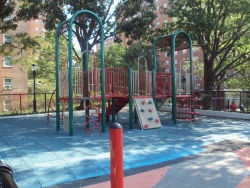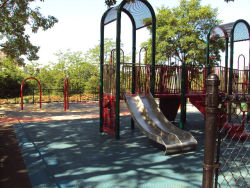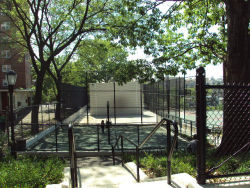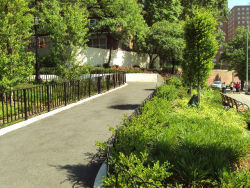Sedgwick Playground
Sedgwick Playground
Major General John Sedgwick (1813-1864) was one of the most revered commanders of the Union Army during the Civil War. A Connecticut native and the son of a Revolutionary War general, Sedgwick graduated from West Point in 1837. At the outbreak of the Civil War, Sedgwick was a major with 24 years of experience, having fought extensively in the Seminole (1835-42) and Mexican (1846-48) Wars.
Warmly nicknamed “Uncle John” by his troops, Sedgwick led his men valiantly in several battles, including Bull Run, Antietam, and Gettysburg, where Sedgwick’s cunning stratagem and auspicious arrival are credited with turning the tide of the battle in favor of the Union. Sedgwick is also famous for his last words, uttered at the Battle of Spottsylvania. When his men sought cover from Confederate sharpshooters, Sedgwick assured them the rebels “couldn’t hit an elephant at this distance.” Moments later, he was shot under his left eye and died instantly.
The city acquired the property for Sedgwick Playground on March 18, 1946 by deed of purchase as part of the Sedgwick Houses housing project. The playground opened on October 15, 1951 and today features two handball courts, three basketball hoops, and numerous swings, slides and seesaws.
The playground and housing complex are located in the Bronx neighborhood known as Morris Heights. The land was acquired before the American Revolution by Richard Morris, the second chief justice of New York State. During the nineteenth century, Lewis and Fordham Morris raised prize cattle on the land. A dock on the Harlem River (1838) and a railroad station (1866) helped to shape the neighborhood’s development. Later, trolley lines connected the area to the subways, and the neighborhood became more prosperous, developing rapidly.
The name Morris appears frequently throughout the history and geography of the Bronx. The name originally dates back to Richard Morris (fl. ca 1662), a prominent landowner who settled on 2,000 acres of land in the southeastern Bronx, and who with his brother Lewis was a major importer of sugar and flour. His great-grandson, Lewis Morris (1726-1798), was the third and final lord of the manor of Morrisania. An ardent patriot, he served in the Continental Congress and signed the Declaration of Independence. His half-brother, Gouverneur Morris, was the greatest Morris of all. Witty and urbane, Morris was renowned as an eloquent speaker, brilliant writer, prominent politician, and major intellect. Despite a career that included a stint in the Continental Congress, several years in the United States Senate, and a ambassadorship to France, his greatest achievement was in writing the final draft of the United States Constitution, giving the document its coherent form and elegant language.
Today, the Bronx is spotted with the name Morris. This includes the neighborhoods of Morrisania, Morris Heights, Morris Park (derived from the Morris Park Racetrack), as well as Morris High School, the first public high school in the country, and an architectural landmark.
Check out your park's Vital Signs
Clean & Safe
Green & Resilient
Empowered & Engaged Users
Share your feedback or learn more about how this park is part of a
Vital Park System





